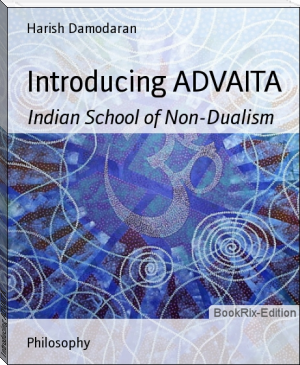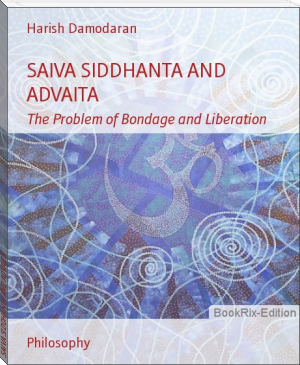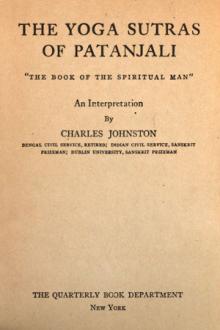Introducing ADVAITA, Harish Damodaran [animal farm read .TXT] 📗

- Author: Harish Damodaran
Book online «Introducing ADVAITA, Harish Damodaran [animal farm read .TXT] 📗». Author Harish Damodaran
Chapter 1
Advaita : The Evolution of the School
The four Vedas- Rig Veda, Yajur Veda, Sama Veda and Atharva Veda- contain the oldest record of philosophical thinking in the world. Besides Vedas and Upanisads, each system of Indian Philosophy, which is designated as darsana, has its own source books such as sutras, bhashyas etc. Sutras contain highly condensed form of philosophic thought and hence require interpretations and commentaries for ordinary men to follow their meaning. Examples of Sutras are: Nyaya Sutra of Gautama, Samkhya Sutra of Kapila, Yoga sutra of Patanjali, Vedanta Sutra of Badarayana etc.
A commentary on the Sutra is called Bhasya. For example Sutra Bhasya of Sankaracharya, SriBhasya of Sri Ramanuja-both are commentaries on Vedanta Sutra of Badarayana.
Six orthodox Indian Schools of thought or Sad darsanas namely - Nyaya of Gautma, Vaisesika of Kanada, Samkhya of Kapila, Yoga of Patanjaly, Mimamsa of Jaimini and Vedanta of Badarayana - accept the authority of the Vedas: Yet, the Nyaya, Vaisesika, Samkhya and Yoga do not originate from vedas; but from corresponding sutras. Mimamsa and Vedanta, unlike the other four thoughts of the Orthodox group are direct interpretations of Vedic Philosophy. Jaimini in his Mimamsa Sutra, interprets Karmakanda (Mantras, Brahmanas and Aranyakas) portion of Vedas, as giving the real purport of Vedas; where as, Vedanta Sutra is upholding Jnanakanda portion (Upanisads) as of philosophic worth. The two sutras; Mimamsa and Vedanta, together investigate the whole of vedic philosophy.
The term ‘Vedanta’ literally means the end of the vedas , which are the Upanisads. The views of Upanisads also constitute the final aim of the Vedas or the essence of the Vedas. The Vedanta sutra of Badarayana, the classical Upanisads such as Isa, Kena, Katha , Prasna, Mundaka, Mandukya, Aitareya, Taittiriya, Chandogya and Brihadaranyaka together with Bhagavat gita constitute the fundamental texts of Vedanta school. These three sources -Upanisads , the Vedanta Sutra and Bhagavat Gita- belong to three different catagories or prastanas. The Upanisads belong to Sruti prasthana, Vedanta Sutra to Nyaya Prasthana, and and the Bhagavat Gita to Smriti Prasthana. Hence these three texts are together called prasthana thraya (three prasthanas) of the Vedanta darsana.
The Vedanta Sutra is also known as Brahma Sutra because it is an exposition of the doctrine of the Brahman. This is again called Saririka Sutra because it deals with the embodiment of the unconditional self. Thus unlike the Mimamsa Sutra of Jaimini that investigates the duties enjoined by the veda, together with rewards there to, the vedanta Sutra of Badarayana describes the philosophical and theological views of the Upanisads. It is a systematic investigation of the various views of the Upanisads.
The Vedanta Sutra consists of 550 Sutras. The sutras are highly intelligible by themselves and leave everything to the interpreter.
As a result, we get different kinds of Vedantic schools, of which Sankaracarya’s Advaita, Sri Ramanuja’s VisistAdvaita and Madhvacarya’s Dvaita are most famous. These three Schools are noteworthy because they represent three distinct ways of understanding the ultimate reality, the Brahman. Advaita stresses the non-dualistic view, VisistAdvaita stands for the qualified non-dualistic view and dvaita puts forward the dualistic view, and all these schools base their different arguments on Brahma Sutra by giving different interpretations.
The Vedanta Sutra has four adhyayas (chapters)-Samanvaya, Avirodha, Sadhana and Phala. The first namely Samanvaya adhyaya deals with theory of Brahaman. Its purpose is reconciliation of the different views on the Brahman such as cosmic view, acosmic view etc.
The second chapter is called Avirodha adhyaya where the author meets the objections brought against these views of Brahaman and he criticizes the rival theories.
The third chapter is called Sadhana adhyaya in which the ways and means of attaining Brahama Vidya is discussed in detail.
The fourth and last chapter namely Phala adhyaya deals with the fruits of Brahama Vidya, and also the description of pitryana (rituals to ancestors) and devayana (way to devotion).
For Badarayana, Veda is eternal. He declares that there is no possibility of discovering metaphysical truth by means of tarka (yukthy) or reflection. Sruti and Smriti are two sources of knowledge. By Sruti Badaryana meant Upanidas and by Smriti he meant Bhagavat geeta, Mahabharata, and code of Manu (Manusmriti). Smriti is dependent on sruti. But Sruti is independent and self-evident. But, to the question whether cosmic view or acosmic view is the higher view, Sutra does not give a clear answer. There fore, Adi Sankaracharya interprets the Sutra view as acosmic view, while, both Sri Ramanuja and Madhavacharya interpret the same as cosmic view. It is on the acosmic view, thus, the doctrine of Advaita is built upon.
By interpreting the Brahma Sutra in the acosmic way, the Advaitin gains a logical footing upon which they can keep their school of thought, Advaita in perfect balance.
Sruti is the name given to the Vedas and the Upanisads which are treated with great respect in Advaita philosophy. The term 'Sruti' means that which is heard. Sages, by long disciplines and preparations, made themselves fit vehicles for receiving and conveying the eternal truth to the rest of the mankind. Sruti gives us what has occurred in the intuitive minds of the saints and the sages at the time of exalted imagination. Hence, Sruti is the word of the Absolute.
In Advaita view the Upanishads are for the sake of the establishment of the immediate experience of Brahman. They are capable of generating immediate as well as mediate knowledge. For example the statement “you are the tenth man” certainly results immediate knowledge of one man being the tenth person for the one who lost himself in counting. Like wise, by listening to the Upanisads one can get immediate intuition of Brahman. If one does not experience so, it is not because the Upanisads are incapable of it. It is only because there is no reasoning involved.
According to Advaita, the Brahman alone is real and it is known by Sruti. But Sruti itself is unreal in the third and highest level of reality. Though unreal, it can sublate the illusory world and reveal Brahman. It is like roar of the dream-lion that can wake one up.
The Scriptures (the Vedas and the Upanisads) are the record of spiritual experience and they do convey an idea of what the Ultimate is like. The special merit of the Scriptures lie in that they alone can reveal any knowledge about the Ultimate.
The Scriptures are composed of sentences or vakyas which in their turn, are composed of words arranged in specific order so as to convey certain meaning words are the vehicles of thought. ‘Sabda’ means sound and word. Sabda pramana is, thus the knowledge derived from the authority of words.
The Advaithins have commentaries on all the ten important upanisads and one later upanisad. They are Isa, Kena, Katha, Prasna, Mandukya, Chandoya, Thaithiriya, Aitharey, Mundaka and Brihadaranyaka along with Svetasvaratha.
The Advaita interprets the Upanisads as the proclamations of acosmic view of the Brahman. Whatever appears to be describing the cosmic view of the Brahman is ascribed to the vyavaharika level of reality. It is meant for the ordinary people to understand the basic principles of philosophy. So, it must not be taken up as anti-advaitic. All descriptions of whole and parts absolute and relative, finite and infinite are transcendent in the Brahman.
When the Isavasya Upanisad declares “isavasyam idam sarvam”, the Advaitin interprets it in an un-orthdox way. Traditional meaning is that “the Lord Isvara dwells everywhere in this world.” But the Advaitin explains this as “the world must be covered with Isvara”. and so on and this does not harm the Advaitic concept of “jagat mithya”.
The Mundaka Upanisad Speaks pure Advaita when it describes the individual soul, like an arrow reaches the target the Brahman and becomes one with it.
In this way, all the major Upanisads are skill fully interpreted in the Advaitic line of thinking. Thus, we can see that the Sruti never contradicts the doctrines of the Advaita Vedanta. Sruti, infact, has given the philosophical back ground upon which the system of Advaita stands.
The Bhagavat Gita (the song celestial) belongs to the Smrithi Prastana. It is an important source of the school of Advaita. Of the three prastanas, the upanisads (sruti prastana) give the philosophical back ground for Advaita, where as, the Brahma Sutra (Nyaya prastana) supplies a logical standpoint of reason. The Advaitins look forword to the third prastana, the Bhagavat Gita, for the guidelines to practice Advaita in daily life. According to them the Bhagavat Gita teaches how to live a life worthy of living, in accordance with the system of Advaita.
The Bhagavat Gita is the teaching of Lord Sri Krishna to Arjuna on the battle field of Kurukshetra. The Bhagavat Gita’s importance in the religio-philosophical literature of India is second only to the Upanisads. The poem, with its 18 chapters form a part of the great epic Mahabharata, where it describes the two rival armies of the Pandavas and the Kauravas engaged against each other.
The occasion, which calls forth the teaching is of extreme seriousness (when the fate of the country as well as the righteousness in peril). It is written in a simple and charming style and is in the form of a dialogue, which gives it a dramatic appearance. The massage that it gives is of supreme value and is applicable to every man in every country. It does not discuss in detail any deep philosophical problems or subtle details of ethics but only gives broad principles relating to term. The most significant attraction of the Bhagavat Gita is its spint of tolerance, which is the most important characteristic of Indian thought.
The central teaching of the Bhagavat Gita is actionism or karmayoga. To understand clearly the meaning of ‘Karmayoga’, the words ‘Karma’ and ‘Yoga’ are to be analysed seperately. ‘Karma’ means ‘What is done’ or ‘a deed’. Karma Signifies that particular form of activity, which is taught in the Karma Kanda of the Vedas namely sacrifice (yoga). But in Bhagavat Gita it signifies duty in accordance with custom and tradition, which were found associated at the time with particular section or class of people, the Varnadharmas, as they are called. Again Karma is used in a sense as to signify divine worship or devotional duty (puja).
The meaning the Bhagavat Gita admits for Karma is that of ‘Social obligation’. The word ‘yoga’ means ‘harnessing’ or ‘applying to oneself. So by ‘karmayoga’ the Bhagavat Gita means ‘devotion to the discharge of social obligation’.
The Bhagavat Gita stresses ‘nishkama karma’ or performing the duties without the least desire for its results. People do karmas because they are attracted by the fruits of the karmas (Karma phala). This is not the kind of the karma, the Bhagavat Gita advocates. Because this kind of Karma is not pure. It is tainted by desire (kama). For the ‘song celestial’, Karma is not a means to an end, but an end in itself. There fore, the aim of the result must be dismissed all together from the mind, before as well as during the act.





Comments (0)